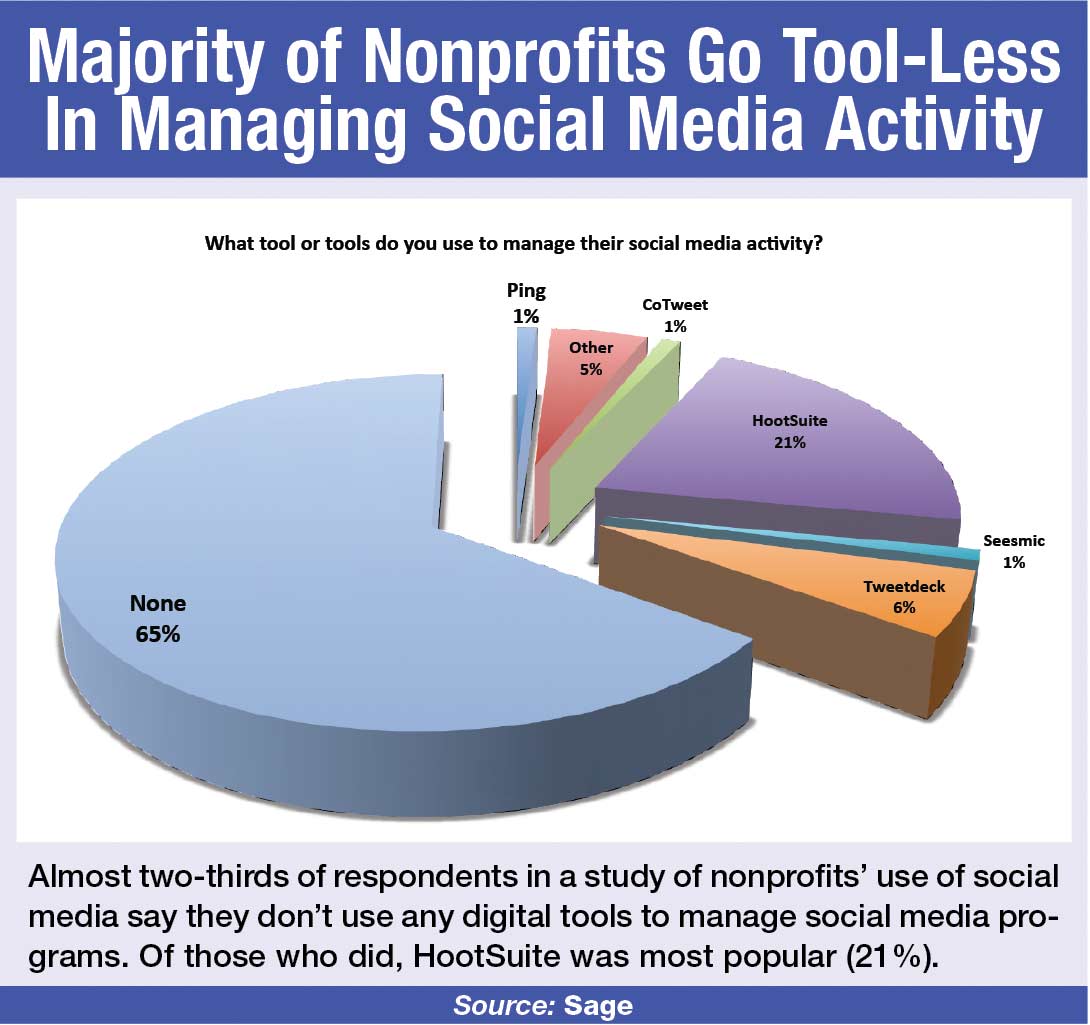 |
Within communications outreach, social media is just about everywhere. To find out just where nonprofits stand in social media awareness, adoption, satisfaction and usage trends, software and service company Sage conducted its second annual Nonprofit Insights study in January 2012, garnering more than 613 respondents from the nonprofit space.
The results show that social media is transforming how nonprofits communicate and engage with their constituents and supporters. Overwhelmingly, 84% of the participants said their organization is using some form of social media, while 73% of the respondents said social media is “very” or “somewhat important” to their organization’s overall mission and strategy.
TOOLS CONFUSING
There were, however, some shortcomings in the use of social media by nonprofits: 69% of respondents say their organizations are not blogging and just 35% use a tool or tools to help manage their social media accounts (see the chart). Choosing management and monitoring tools can be a perplexing process, so we reached out to some organizations to find out if and what they are using to track social media programs.
With a large number of social media content contributors, Duke University’s Fuqua School of Business uses HootSuite for account management, says Elizabeth Hogan, Fuqua’s assistant dean of marketing.
Fuqua employs a variety of social platforms with multiple users, including Twitter, Facebook, YouTube, LinkedIn and others. With Facebook, Hogan depends on its internal Insights tool for tracking and measurement. In terms of paid tools, “a lot of our peers are using Radian6, and we’re looking at tools like that as well,” says Hogan.
SOCIAL MEDIA GROWS UP
In the academic world, social media was purely elementary a few years ago, but now it’s going post-grad. “We’re beginning to grow up,” adds Hogan. On her social media management wish list: tools that help respond socially in real time as well as ones that can track influence and brands.
Meanwhile, at IES Abroad, a third-party study abroad provider, e-marketing manager Jeanne Haegele didn’t want to give away the farm, but did reveal a few basic tools she uses.
On the monitoring side, Google Alerts tracks several relevant keywords, including competitors. And TweetDeck monitors Twitter.
One tool that Haegele strongly recommends is Google Reader, which aggregates blogs. “It’s a no-brainer and easy to use,” she says.
Note that the tools Haegele uses are free. IES Abroad deploys five social platforms—Facebook. Twitter, LinkedIn, YouTube and Pinterest. Haegele says the effectiveness of Pinterest remains to be seen. “Right now we’re sharing travel posts, articles and great photography,” says Haegele. “We want to keep it much like our Facebook presence—a very social atmosphere.”
Both Hogan and Haegele are satisfied with their organizations’ social media presence so far. In the Sage survey, almost half of the respondents (46%) are “somewhat” or “very satisfied” with their success in social media.
Unfortunately, that means that over half of the respondents aren’t too happy with their social media efforts. PRN
CONTACT:
Elizabeth Hogan, [email protected]; Jeanne Haegele, [email protected].
Follow Scott Van Camp: @svancamp01
